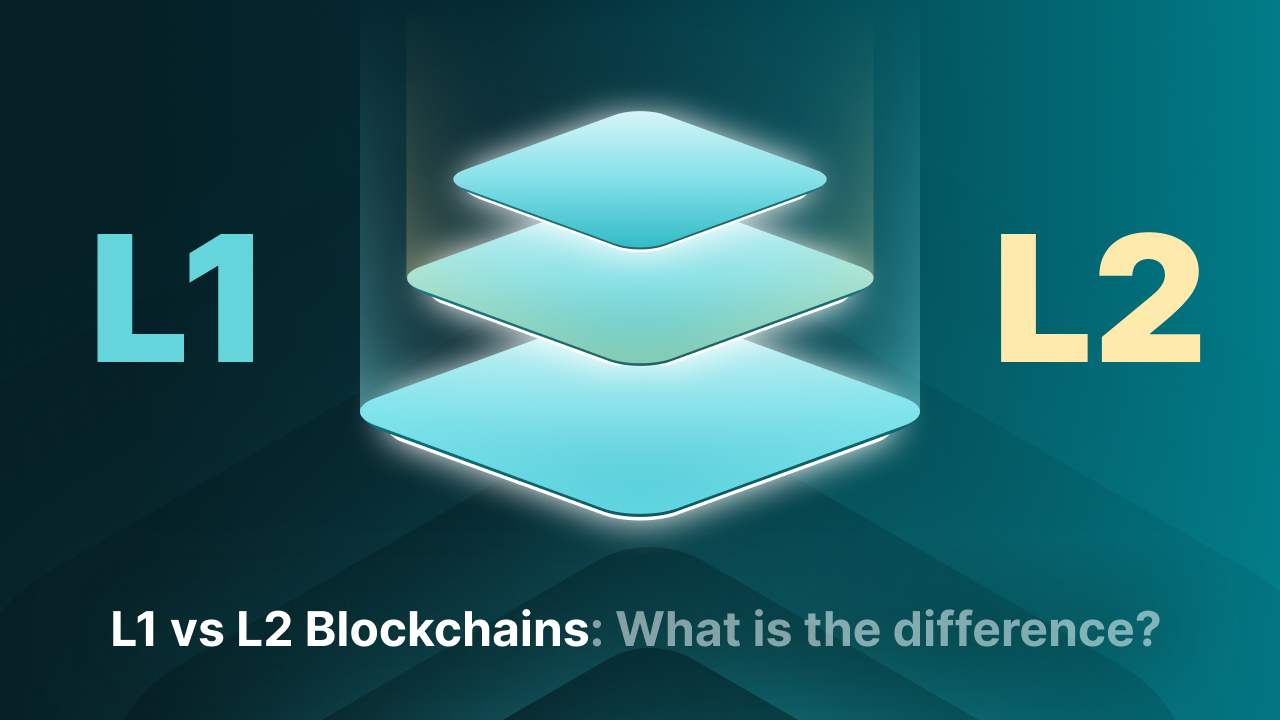The Difference Between Layer 1 and Layer 2 Blockchains

In the world of blockchain technology, Layer 1 and Layer 2 solutions have become common buzzwords. These terms are often used to describe two different approaches to scaling blockchain networks, but what exactly do they mean?
In this article, we’ll break down the differences between Layer 1 and Layer 2 blockchains, how they work, and why they’re critical to the future of decentralized systems.
What is a Layer 1 Blockchain?
A Layer 1 blockchain refers to the base or foundational network of a blockchain. This is the core architecture where transactions occur, and it includes the primary consensus mechanism that ensures the network remains secure and decentralized. Bitcoin (BTC), Ethereum (ETH), and Solana (SOL) are prime examples of Layer 1 blockchains.
Layer 1 blockchains are the original blockchains, and they are responsible for processing all transactions directly on the chain. They are self-sufficient in terms of network security, consensus, and transaction validation. However, as blockchain adoption grows, these networks face significant challenges, particularly in terms of scalability.
The Scalability Problem with Layer 1 Blockchains
As the popularity of blockchain networks like Bitcoin and Ethereum has surged, they’ve struggled with performance bottlenecks. The biggest issue is their limited ability to handle a large volume of transactions efficiently.
For example:
-
Bitcoin can process about 7 transactions per second (TPS).
-
Ethereum can process roughly 30 TPS.
In comparison, traditional payment systems like Visa can handle thousands of transactions per second, exposing the gap in blockchain scalability. As more people use the network, transaction times slow down, and fees increase, making the user experience less than ideal. To address these issues, developers have been working on Layer 1 scaling solutions, such as sharding and consensus mechanism improvements (like Ethereum’s transition from Proof of Work to Proof of Stake). But even these enhancements can’t fully resolve the problem on their own.
This is where Layer 2 solutions come into play.
What is a Layer 2 Blockchain?
A Layer 2 blockchain is an overlaying network that sits on top of a Layer 1 blockchain to increase its scalability. Layer 2 solutions aim to offload some of the transactional burden from the Layer 1 network, allowing the base layer to focus on security and decentralization, while the Layer 2 network handles the processing of large numbers of transactions more efficiently.
Layer 2 blockchains do not alter the underlying protocol of Layer 1. Instead, they work in parallel with it, processing transactions off-chain and settling them on the base layer in batches. This approach can dramatically improve transaction throughput and reduce fees.
Popular Layer 2 solutions include:
-
Bitcoin’s Lightning Network: Designed to facilitate faster, low-cost transactions by creating off-chain payment channels that are later settled on the Bitcoin blockchain.
-
Ethereum’s Optimistic Rollups: A scaling solution that processes transactions off-chain and only submits the final state to Ethereum, significantly reducing congestion and gas fees.
-
Polygon: A Layer 2 protocol built to help Ethereum scale by offering faster and cheaper transactions while still benefiting from Ethereum’s security.
Key Differences Between Layer 1 and Layer 2 Blockchains
Now that we’ve defined what Layer 1 and Layer 2 blockchains are, let’s break down their main differences:
Functionality
-
Layer 1: The base layer where all the essential blockchain operations occur. It is responsible for security, consensus, and transaction validation.
-
Layer 2: A supplementary layer that operates above Layer 1, handling transaction processing to alleviate congestion on the main chain.
Scalability
-
Layer 1: Limited scalability, especially when network demand is high. Scaling solutions are in development, but their effectiveness is still evolving.
-
Layer 2: Significantly enhances scalability by processing transactions off-chain and reducing the load on Layer 1.
Transaction Speed
-
Layer 1: Transaction speed is typically slower due to the network’s need to prioritize security and decentralization.
-
Layer 2: Can dramatically increase transaction speed by processing transactions off-chain before settling them on Layer 1.
Transaction Fees
-
Layer 1: As network congestion increases, so do transaction fees. For example, Ethereum’s gas fees can spike dramatically during high-traffic periods.
-
Layer 2: Lower transaction fees as they offload much of the work from the main chain, making it more affordable for users.
Security
-
Layer 1: Highly secure, as it is the foundational blockchain that ensures consensus and protects against attacks.
-
Layer 2: Relies on the security of the Layer 1 chain. While Layer 2 processes transactions more efficiently, it eventually submits data to Layer 1 for final settlement, ensuring that security is maintained.
Use Cases
-
Layer 1: Best suited for large, critical, and secure transactions where decentralization is the top priority.
-
Layer 2: Ideal for day-to-day transactions, microtransactions, or decentralized applications (dApps) that require fast and cheap interactions.
Why Both Layers Are Necessary
Both Layer 1 and Layer 2 solutions are necessary to create a well-functioning, scalable, and secure blockchain ecosystem. Layer 1 blockchains lay the foundation with robust security and decentralization, but without Layer 2 solutions, these networks would be too slow and costly for mass adoption.
Layer 2 scaling solutions provide the speed and efficiency needed for blockchain technology to be feasible for widespread use, especially in industries like finance, gaming, and supply chain management. They enable seamless transactions without sacrificing the decentralization and security that make blockchain networks so revolutionary.
Conclusion
In summary, the difference between Layer 1 and Layer 2 blockchains comes down to their roles in the overall network structure. Layer 1 provides the foundation for security and consensus, while Layer 2 enhances scalability by reducing congestion and improving transaction efficiency. Together, they form the backbone of a decentralized future that is secure, scalable, and ready for mass adoption.
Understanding these differences is key to navigating the evolving blockchain landscape. As the industry grows, both Layer 1 and Layer 2 solutions will play a vital role in overcoming the scalability challenges that lie ahead.
